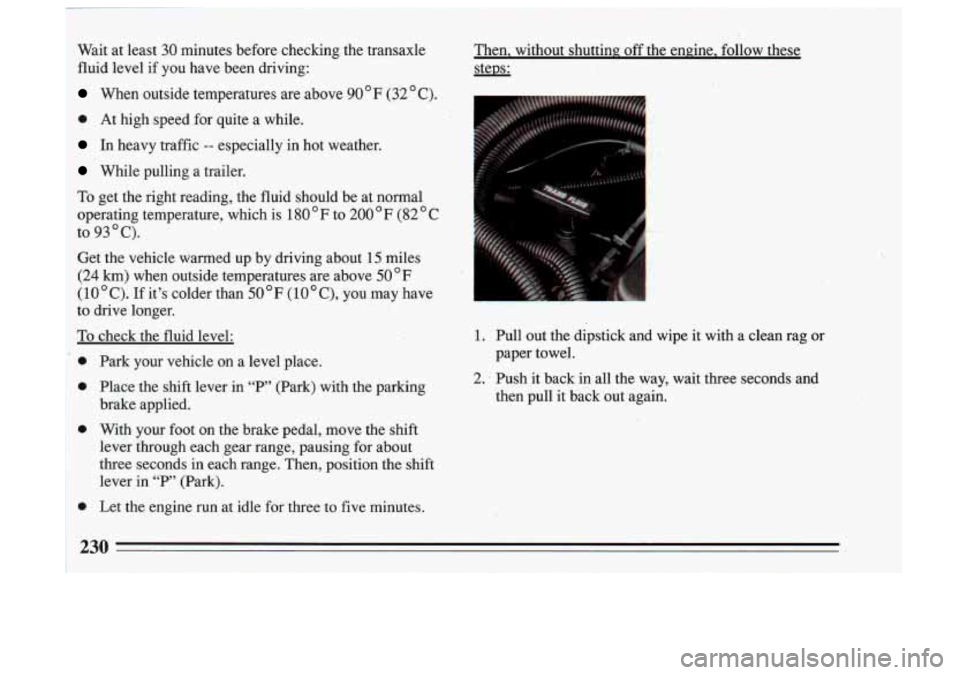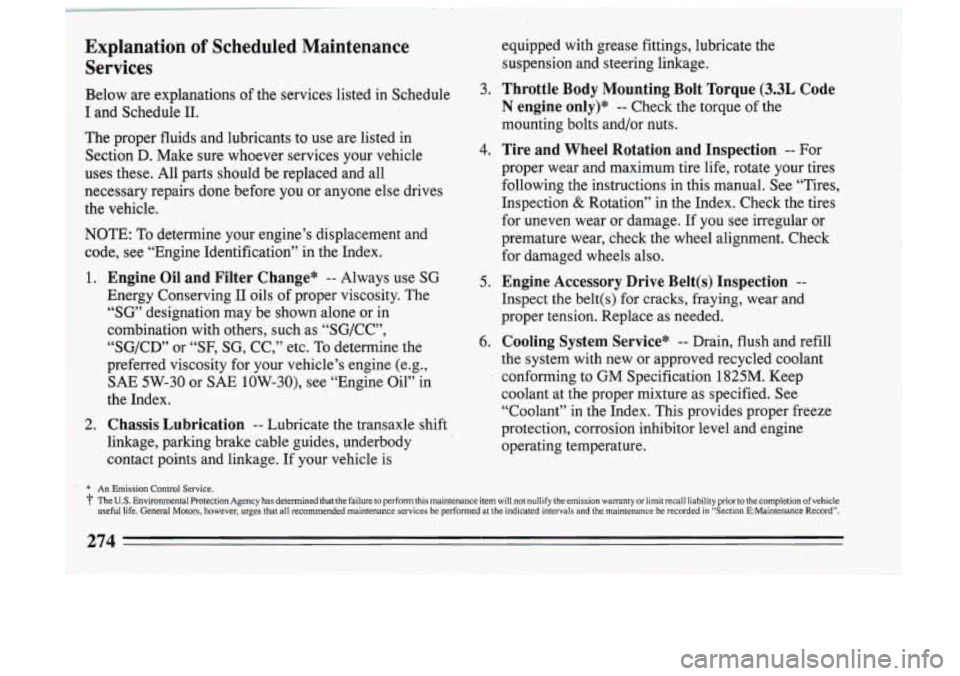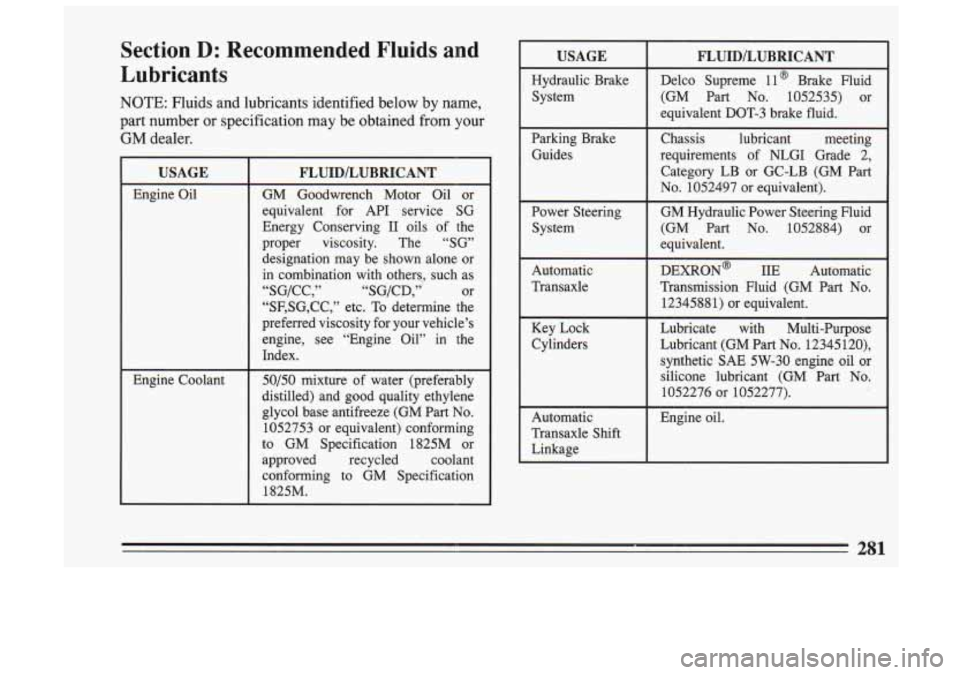1993 BUICK SKYLARK parking brake
[x] Cancel search: parking brakePage 231 of 306

Wait at least 30 minutes before checking the transaxle
fluid level if you have been driving:
When outside temperatures are above 90 ’ F (32 ’ C).
0 At high speed .for quite a while.
In heavy traffic -- especially in hot weather.
While pulling a trailer.
To get the right reading, the fluid should be at normal
operating temperature, which is 180’F to 200’F (82OC
Get the vehicle warmed up by driving about
15 miles
(24 km) when outside temperatures are above 50’F
(1 0 C). If it’s colder than 50 OF (10 ’ C), you may have
to drive longer.
To’check the fluid level:
to 93
“C).
0
e
0
Park your vehicle on
a level place.
Place the
shift lever in “F”’ (Park) with the parking
brake applied.
With your foot on the brake pedal, move the shift
lever through each gear range, pausing for about
three seconds
in each range. Then, position the shift
lever
in “P,’ (Park).
Let the engine
run at idle far three to five minutes. Then; without shutting off the engine, follow these
steps:
.I. Pull out the dipstick and wipe it with a clean rag or
paper towel.
2. . Push it back in all the way, wait three seconds and
then pull it back out again.
Page 259 of 306

Fuses and Circuit Breakers
The wiring circuits in your car are protected from short
circuits.by a combination of fuses, circuit breakers, and
fusible thermal links in the wiring itself. This greatly
reduces the chance of fires caused by electrical
problems.
Be sure to use the correct fuse. If you ever have a
problem on the road and don’t have a spare fuse, you
I
can “borrow” one of the identical size and rating. Just
pick some feature of your car that you can get along
without
-- like the radio or cigarette lighter -- and use its
fuse, if it is of the value you need. Replace it as soon as
you can.
The fuse panel
is to the left of the steering column, near
the parking brake release lever. Pull the cover down to
access the fus.es.
I
258
Page 275 of 306

Explanation of Scheduled Maintenance equipped with grease fittings, lubricate the
Services suspension and steering linkage.
Below are explanations
of the services listed in $chediie ‘ ‘ 3. Throttle Body Mounting; Bolt Torque (3.3L Code . , I:
I and Schedule 11.
The proper fluids and lubricants to use are listed in
Section
D. Make sure whoever services your vehicle
uses these. All parts should be replaced and all
necessary repairs done before you or anyone else drives
the vehicle.
NOTE:
To determine your engine’s displacement and
code, see “Engine 1dentific.ation” in the Index.
1. Engine Oil and Filter Change* -- Always use SG
Energy Conserving
I1 oils of proper viscosity. The
“SG, designation may be shown alone or in
combination with others, such as “SG/CC”,
“SG/CD” or “SF,
SG, CC,” etc. To determine the
preferred viscosity for your vehicle’s engine (e.g.,
SAE 5W-30 or SAE 10W-30), see “Engine Oil” in
the Index.
2. Chassis Lubrication -- Lubricate the transaxle shift
linkage, parking brake cable guides, underbody
contact points and linkage. If your vehicle is
An Emission Control Service.
N engine only)* -- Che& the torque of the
mounting bolts and/or nuts.
proper wear and maximum tire life, rotate your tires
following the instructions in this manual. See “Tires,
Inspection
& Rotation” in the Index, Check the tires
for uneven wear or damage. If you see irregular or
premature wear, check
the wheel alignment. Check
for damaged wheels also.
5. Engine Accessory Drive Belt@) Inspection --
Inspect the belt(s) for cracks, fraying, wear and
proper tension. Replace as needed.
6. Cooling System Service* -- Drain, flush and refill
the system with new or approved recycled coolant
conforming to GM Specification 1825M. Keep
coolant at the proper mixture as specified. See
“Coolant” in the Index. This provides proper freeze
protection, corrosion inhibitor level and engine operating temperature.
4. Tire and Wheel Rotation and Inspection -- For
The U.S. Environmental Protection Agency has determined that the failure to perform this maintenance item will not nullify the emission war\
ranty or limit recall liability prior to the completion of vehicle
useful life. General Motors, however, urges that all recommended maintenance services be performed at the indicated i\
ntervals and the maintenance be recorded in “Section EMaintenance Record”.
274
Page 278 of 306

At Least Once A Month
CHECK OR SERVICE
Tire Inflation
WHAT TO DO
Check tire inflation. Make sure they
are inflated to the pressures specified
on the Tire-Loading Information
label located on the rear edge of the
driver’s door. See “Tires” in the
Index for further details.
At Least Once A Year
CHECK OR
SERVICE
I WHAT TO DO
Key Lock
Lubricate all body door hinges. Also
Body the
lubricant specified in Section
D. Cylinders Lubricate the
key lock cylinders with
Lubrication lubricate all hinges and latches,
including those for the hood, glove
box door and console door. Section
D tells you what to use.
CHECK OR
SERVICE
Starter Switch
WHAT TO DO
kAUTION: When you are
doing this check, the vehicle
could move suddenly.
If it
does, you or others could be
injured. Follow the steps
bellow.
- 1
1. Before you start, be sure you have
enough room around the vehicle.
2. Firmly apply both the parking brake
(see “Parking Brake” in the Index if
necessary) and the regular brake.
NOTE:
Do not use the accelerator
pedal, and be ready to
turn off the
engine immediately if it starts.
3. Try to start the engine in each gear.
The starter should work only in
“P’
(Park) or “N” (Neutral). If the starter
works in any other position, your
vehicle needs service.
277
Page 281 of 306

INSPECTION
OR SERVICE
Steering,
Suspension and
Front-Wheel-
Drive Axle
Boot and Seal
Inspection
Exhaust System
Inspection
Throttle
Linkage Inspection
WHAT SHOULD BE DONE
hspect the front and rear suspension
and steering system for damaged,
loose or missing parts, signs of wear,
or lack of lubrication. Inspect the
power steering lines and hoses for
proper hookup, binding, leaks, cracks, chafing, etc. Clean and then
inspect the drive axle boot seals for
damage, tears or leakage. Replace
seals
if necessary.
Inspect the complete exhaust system. Inspect the body near the
exhaust system. Look for broken,
damaged, missing or out-of-position
parts as well as open seams, holes,
loose connections,
or other
conditions which could cause a heat
build-up in the floor pan or could let
exhaust fumes into the vehicle. See
“Engine Exhaust” in the Index.
Inspect the throttle linkage for interference or binding, and for
damaged or missing parts. Replace
parts as needed.
“:
INSPECTION
OR SERVICE
Brake System
Inspection
WHAT SHOULD BE DONE
Inspect the complete system. Inspect
brake
lines and hoses for proper
hookup, binding, leaks, cracks, chafing,
etc.
Inspect disc brake pads for wear
and rotors for swrface condition.
Also
inspect Qwn brake linings for wear and
cracks. Inspect other brake
parts
including drums, wheel cylinders,
calipers parking brake, etc. The parking
brake is self-adjusting and no manual adjustment
is required. You may need
to have your brakes inspected more often
if your driving habits or
conditions result in frequent braking.
NOTE: A low brake fluid level can
indicate worn disc brake pads which
may
need to be serviced. Also, if the
brake system warning light stays on or
comes on, something may
be wrong
with the brake system. See “Brake System
Warning Light” in the Index. If
your anti-lock brake system warning
light stays
on, comes on or flashes,
something may
be wrong with the
anti-lock brake system. See “Anti-Lock
Brake System Warning Light”
in the
Index.
280 .~ . ~
Page 282 of 306

Section D: Recommended Fluids and
Lubricants
NOTE: Fluids and lubricants identified below by name,
part number or specification may be obtained from your
GM dealer.
USAGE
Engine Oil
Engine Coolant
FLUID/LUBRICANT
GM Goodwrench Motor Oil or
equivalent for API service SG
Energy Conserving I1 oils of the
proper viscosity. The
“SG’
designation may be shown alone or
in combination with others, such as
“SGICC,”
66~~/~~,991 or
“SF,SG,CC,” etc. To determine the
preferred viscosity for your vehicle’s
engine, see “Engine Oil” in the
Index.
50/50 mixture of water (preferably
distilled) and good quality ethylene
glycol base antifreeze (GM Part No.
1052753 or equivalent) conforming
to GM Specification 1825M or
approved recycled coolant
conforming to GM Specification
1825M.
USAGE
Hydraulic Brake
System
Parking Brake
Guides
Power Steering
System
Automatic
Transaxle
Key Lock
Cylinders
Automatic
Transaxle Shift
Linkage
FLUIDlLUBRICANT
~~
Delco Supreme 11 @ Brake Fluid
(GM Part No. 1052535) or
equivalent DOT-3 brake fluid.
Chassis lubricant meeting
requirements of NLGI Grade 2,
Category LB or GC-LB (GM Part
No. 1052497 or equivalent).
GM Hydraulic Power Steering Fluid
(GM Part No. 1052884) or
equivalent.
DEXRON@ IIE Automatic
Transmission Fluid (GM Part
No.
12345881) or equivalent.
Lubricate with Multi-Purpose
Lubricant (GM Part
No. 12345120)’
synthetic
SAE 5W-30 engine oil or
silicone lubricant
(GM Part No.
1052276 or 1052277).
Engine oil.
281
Page 300 of 306

.... +,..
Maintenance Inspections
.................................. 279
Record
...................................... 282
Schedule
.................................... 265
Underbody
.................................. 255
Malfunction Indicator Lamp
....................... 1 13
Manual Lumbar Support
........................... 15
Manualseat
..................................... 14
Manual Seat. Four Way
............................ 15
Markings. Pavement
............................. 144
Master Cylinder. Brake
........................... 236
Methanol In Gasoline
............................. 217
Mirrors
........................................ 102
Mirrors. Convex Outside
.......................... 104
Mirrors. Visor Vanity
............................. 104
Mist. Driving in
................................. 164
Mountain Driving
................................ 170
MTBE in Gasoline
............................... 2 17
. Mobile Telephone. Adding a ....................... 123 Octane
Required for Your Car
..................... 217
Odometer
...................................... 108
Odometer. Trip
.................................. 108
Off (Ignition Key Position)
......................... 73
Off-Road Recovery
.............................. 156
Oil. Engine
..................................... 223
Oil Pressure Warning Light
........................ 114
Oil. Change Your Engine
.......................... 223
Operation in Foreign Countries
..................... 218
Operation
of Lights ............................... 90
Outside Mirrors ................................. 103
Overheated Engine
............................... 197
Owner Checks and Services
........................ 276
P (Park) Position ................................. 77
Paint Spotting
................................... 255
Park. Shifting Into
................................ 81
Park. Shifting Out of
........................... 77. 83
Parking Brake
.................................... 80
Parking on Hills
................................. 172
N (Neutral) Gear Position ......................... 78 Parking Over Things That Burn ...................... 84
Net. Convenience
................................ 104 Passing ........................................ 156
New Vehicle Break-In
............................. 71 Pavement Markings .............................. 144
NightDriving
................................... 159 PedalTravel. Brake .............................. 153
Night Vision
.................................... 160 Perception Time in Braking ........................ 149
Notices About Damage
............................ 11 Periodic Maintenance Inspections ................... 279
Number. Vehicle Identification
..................... 257 Polishing and Waxing ............................ 253
Page 304 of 306

...... a . c
Underbody Maintenance ......................... 255
Uniform Tire Quality Grading
...................... 245
Unleaded Gasoline
............................... 2 17
Uphill Parking
.................................. 173
Upholstery Care
................................. 249
Used Oil. How to Dispose
of ....................... 227
Used Replacement Wheels
......................... 248
Vehicle Damage Warnings
......................... 11
Vehicle Identification Number ...................... 257
Vehicle Storage
................................. 237
Vehicle Symbols
.................................. 12
Volts Gage
..................................... 116
Vinyl. Cleaning
................................. 251
Visor Vanity Mirror
.............................. 104
warnings Devices
.............................. 187
Warning. Hazard Flasher
.......................... 186
Warning Lights
Antilock Brake System
......................... 11 1
Battery
....................................... 116
Brakesystem
................................ 110
CheckOil
................................... 115
Engine Coolant Temperature
.................... 112
Engine Oil Pressure
............................ 114
Indicators and Gages on Instrument Panel
.......... 109
LowCoolant
................................. 113
Malfunction Indicator (Service Engine Soon)
....... 11 3
I
Warnings. Safety ................................. 10
Washer. Windshield
............................... 92
Wear Indicators. Disc Brake
....................... 152
Weather Strips
.................................. 254
Weight.of a Trailer
............................... 180
Wheel Alignment
................................ 246
Wheel Covers Removal
........................... 206
Wheel Replacement
.............................. 247
White Sidewall Tire Cleaning
...................... 254
Why Wear Safety Belts?
........................... 23
Windows. Power
................................. 87
Windshield
Cleaning
.................................... 252
Washer
..... : ................................ 92
Washer Fluid
.............................. 92. 235
Wipers
................................... 9252 1.
Winter Driving
.................................. 175
Working on Your Car
............................. 216
Worn Tires
..................................... 244
Wrecker Towing
................... ............. 193
Washing Your Vehicle
............................ 253
WheelNutTorque
............................... 211
Your Driving and the Road
....................... 137
Your Own Signals
............................... 144
Your Vehicle and the Environment
.................. 267